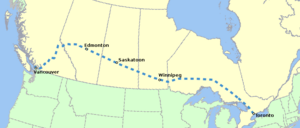Super Continental
The Super Continental was a transcontinental Canadian passenger train operated originally by the Canadian National Railway beginning in 1955 and subsequently by VIA Rail Canada from 1977 until its cancellation in 1981. Service was restored in 1985 but was again eliminated in 1990. The original CNR train had a Montreal - Ottawa - Toronto - Winnipeg - Saskatoon - Edmonton - Jasper - Vancouver routing with daily service.
Contents
CNR passenger service in the postwar era
Following World War II, CNR's passenger fleet was in desperate need of modernization, and between 1946 and 1950 they purchased a total of 75 of new lightweight coaches and sleeping cars. However, post-war material shortages constrained the number of cars that CNR was able to procure commercially, leading to a significant programme of in-house refurbishment of older heavyweight equipment in the CNR carshops. Ultimately a total of 211 heavyweight cars were fitted out with new interiors, roller bearing trucks, and sealed windows. Nevertheless it quickly became apparent that refurbished equipment alone would not be sufficient to remain competitive, and in 1952 CNR placed a large order for new lightweight equipment. This order consisted of 218 coaches from the Canadian Car and Foundry Company in Montreal, as well as 92 sleeping cars, 20 dining cars, 17 parlour cars, and 12 buffet-sleepers from the Chicago-based Pullman-Standard Company.
Inauguration of service
Deliveries of the new cars were essentially completed by 1954, but CNR waited until 24 April 1955 to introduce its new transcontinental flagship Super Continental to replace its former flagship, the Continental Limited. Not coincidently, this was the same date that competitor Canadian Pacific Railway introduced its new streamlined transcontinental train The Canadian. However, despite the new and refurbished equipment and an attractive new black-and-green yellow-trim paint scheme, the Super Continental's mixture of equipment paled in comparison to CPR's gleaming all stainless-steel consist, produced for them by the Budd Company. An additional important distinction was that The Canadian featured scenic dome cars, which the Super Continental was prevented from using due to interference with electrification in Montreal. In 1964, CN started using dome cars on the western portion of the route.
Although the CNR was not completely dieselized until 1960, the Super Continental was from the outset hauled exclusively by a variety of diesel locomotives, including Montreal Locomotive Works FP-2s and FP-4s, Canadian Locomotive Company C-liners in eastern Canada, as well as General Motors Diesel FP9 units in western Canada.
Decline of passenger trains
By the 1960s, Canadian passenger trains were in serious decline, largely thanks to increased competition from automobiles travelling the then-new Trans-Canada Highway and from airlines. However, the CN aggressively marketed its services, even while CPR was losing interest in operating The Canadian. To help combat the perception that the CPR route through the Rocky Mountains was more scenic, CN in 1964 acquired a set of six ex-Milwaukee Road "Super Dome" cars (rechristened "Sceneramics" by CN) that had formerly seen service on the Olympian Hiawatha. These were placed into service between Winnipeg and Vancouver. But despite CNR's best efforts, ridership continued to decline throughout the 1970s, and the train operated at a loss.
VIA Rail takeover and first cancellation
On April 1, 1978, a new federal Crown corporation called VIA Rail Canada formally assumed responsibility for the passenger services of CN. VIA Rail also assumed responsibility for CP Rail's passenger services on October 29, 1978, giving it two transcontinental routes: the Canadian and the Super Continental. VIA Rail reconfigured these routes, making the Canadian a Toronto–Vancouver train and the Super Continental a Montreal–Vancouver train. Sleeping cars were exchanged in Winnipeg between the two trains. The Canadian became the company's premier transcontinental train and the Super Continental was relegated to secondary status. Nevertheless, a confluence of astute marketing, high gasoline prices, and rampant inflation actually led to an increase in ridership during the early 1980s. However, the 1981 federal budget of Prime Minister Pierre Trudeau's Liberal government led to fully 20% of VIA's route miles being eliminated. The Super Continental was among the trains immediately cut.
Such reductions in passenger service proved to be politically unpopular, and following the election of the Progressive Conservative government of Brian Mulroney in 1984, service was restored on June 1, 1985, but on a truncated route from Vancouver to Winnipeg via Edmonton that no longer lived up to the 'Continental' name. The Toronto/Montreal to Sudbury segment was eliminated, and the Capreol–Winnipeg segment was reduced to a triweekly nameless remote services train. During this period, VIA Rail was also able to re-equip the Super Continental with modern GMD F40PH locomotives. Unfortunately, on February 8, 1986 human error resulted in VIA's eastbound Super Continental colliding with a CN freight train at Dalehurst, Alberta, near Hinton. Twenty-three people lost their lives in what is still the worst accident in modern Canadian railway history.
The end
By the late 1980s, federal budgets were under serious pressure, and the Mulroney government's 1989 budget proved disastrous for VIA rail. The last trains left Winnipeg & Vancouver on January 14, 1990, afterwards the Super Continental was abolished. This left The Canadian as VIA's sole transcontinental train, which today operates three times a week Vancouver to Toronto only over the CN route of the original Super Continental rather than on its original CPR trackage. This gave rise to its nickname — the "Con-adian".
References
- Classic Trains, Spring 2005, Kalmbach Publishing, ISSN 1527-0718 pg. 67

